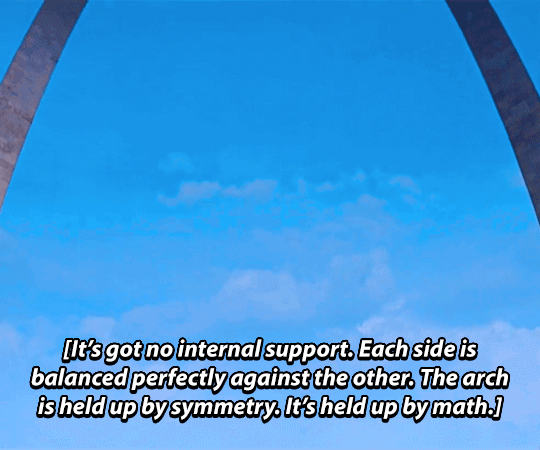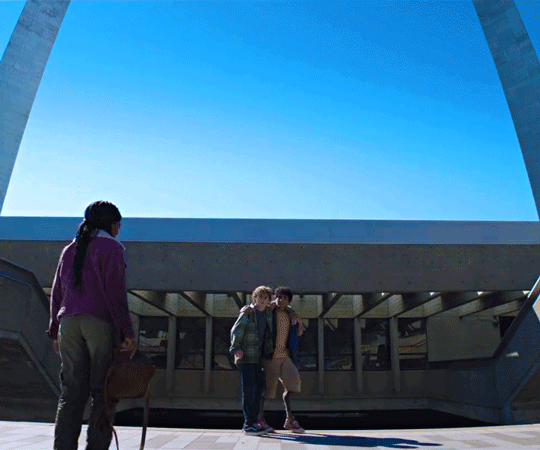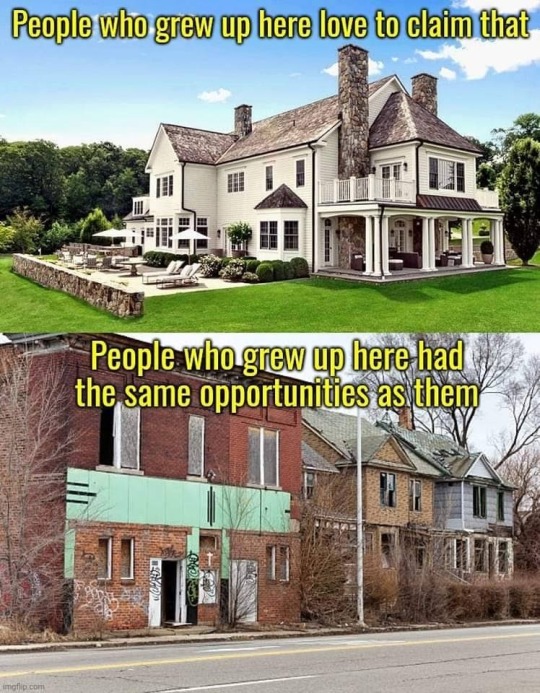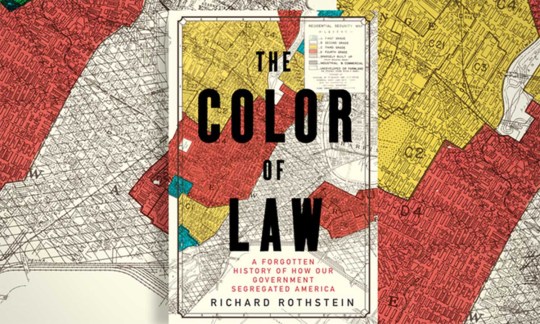#Redlining
Explore tagged Tumblr posts
Text
Justice 40
Joe Biden is boring and often bad at tooting his own horn, but by god, he is good at process.
Justice 40 is simple but powerful application of that. its a shift in how the executive branch works. 40% of money from a bunch of existing programs should go to census tracts that are overburdened with pollution, at higher risk for climate change, and have been historically underserved.
The shorthand here is basically "communities that don't have enough internal resources to deal with long term problems". So yes, communities that had been redlined for decades, ones that have Superfund sites, ones that have high rates of asthma from air pollution.
and this is by census tract. Not city. census tract. So parts of New York City qualify... but other parts don't. And the city HAS to use the money in the targeted part. it doesn't go into the communal pool. it's for THAT tract specifically.
Also all land federally recognized as belonging to a Native American tribe and all Alaskan Native Villages qualify, specifically.
And again, this is for existing programs that are already running and have existing staff and budgets. They're supposed to prioritize grants and projects for those areas specifically. And that's everything from Department of Agriculture, to FEMA, to Labor, to Environmental Protection.
Does it instantly get rid of all the baked in racism from decades past? No, not even close. But it puts in a countermeasure that has a concrete and measurable goal to aim for rather than a nebulous "suck less." even if the administration changes, many of those changes will stick.
And as things improve, some tracts may come off the list! Some may go on that weren't there before!
You can see a map here. Blue highlighted tracts are "disadvantaged" so qualify for that extra assistance! Check and see if you live in one or part of your town does. Because if you've been hearing constantly "we can't afford to fix X problem..." and you're in that tract.... there's money available. For you. Build that sidewalk, fix those lead pipes, get that brush truck your volunteer fire department has been asking for.
And tell your local officials that! "did you look at Justice 40 for funding". And even if they're doing their best, particularly people in little towns.... being a government official isn't their full time job. They may have missed it. Just asking them about the program may suddenly open a world of possibilities.
9K notes
·
View notes
Text
#Repost @theredlinevenice
——
Venice, CA wasn’t just built on sand—it was built on the strength, skill, and perseverance of African Americans. 💪🏾 From constructing the canals to laying the rail lines, Black workers played a crucial role in shaping this coastal paradise. Yet, redlining and racial covenants tried to erase their place in history.
The Redline Venice is here to reclaim that legacy. 🏡✊🏾 It’s more than a space—it’s a movement.
#n.e.w.s. brand#n.e.w.s.#n.e.w.s#news brand 88#n.e.w.s.brand#steer your destiny#los angeles#california#redlining#african american#black history#black american#black americans#history#america#american#88#2025#winter#winter solstice#winter '25#black excellence#black people#cali#southern california#so cal#socal#southern cali#build#builders
100 notes
·
View notes
Text








“Annabeth craned her neck to see the Gateway Arch, which looked to me like a huge shopping bag handle stuck on the city.” The Lightning Thief page 202
PERCY JACKSON AND THE OLYMPIANS 1x04 + 1x05: A Typical Day in St. Louis
“The highway also cut off many residents—mainly poor and black—from the development around the arch, aggravating racial tensions still fresh from when construction unions barred African-Americans from working on the site. The displacement came to epitomize 20th-century ‘urban renewal’—a euphemism, James Baldwin quipped, for Negro removal.’” Fred Kaplan for The Smithsonian Magazine, The Twisted History of the Gateway Arch
#100#sliced bread#bread stuff#pjo#st louis#gateway arch#percy jackon and the olympians#police cw#pjoedit#pjo tv show#pjo series#percy jackson tv show#percy jackson#annabeth chase#grover underwood#disney#the lightning thief#pjosource#pjotvedit#percyjacksonedit#tvedit#eero saarinen#redlining#for the rest of my life i’m gonna be pointing at the fourth gif going ‘see that speck? that’s percy jackson falling from the gateway arch’#and they’ll say ok grandpa let’s get you to bed#fuck slpd btw
157 notes
·
View notes
Text

#american lies#white lies#economics#american games#disinfranchisement of Americans#Freedmen#Black Lives Matter#Black History Matters#Redlining#Economic Issues
341 notes
·
View notes
Text
Sphinxmumps Linkdump

On THURSDAY (June 20) I'm live onstage in LOS ANGELES for a recording of the GO FACT YOURSELF podcast. On FRIDAY (June 21) I'm doing an ONLINE READING for the LOCUS AWARDS at 16hPT. On SATURDAY (June 22) I'll be in OAKLAND, CA for a panel and a keynote at the LOCUS AWARDS.

Welcome to my 20th Linkdump, in which I declare link bankruptcy and discharge my link-debts by telling you about all the open tabs I didn't get a chance to cover in this week's newsletters. Here's the previous 19 installments:
https://pluralistic.net/tag/linkdump/
Starting off this week with a gorgeous book that is also one of my favorite books: Beehive's special slipcased edition of Dante's Inferno, as translated by Henry Wadsworth Longfellow, with new illustrations by UK linocut artist Sophy Hollington:
https://www.kickstarter.com/projects/beehivebooks/the-inferno
I've loved Inferno since middle-school, when I read the John Ciardi translation, principally because I'd just read Niven and Pournelle's weird (and politically odious) (but cracking) sf novel of the same name:
https://en.wikipedia.org/wiki/Inferno_(Niven_and_Pournelle_novel)
But also because Ciardi wrote "About Crows," one of my all-time favorite bits of doggerel, a poem that pierced my soul when I was 12 and continues to do so now that I'm 52, for completely opposite reasons (now there's a poem with staying power!):
https://spirituallythinking.blogspot.com/2011/10/about-crows-by-john-ciardi.html
Beehive has a well-deserved rep for making absolutely beautiful new editions of great public domain books, each with new illustrations and intros, all in matching livery to make a bookshelf look classy af. I have several of them and I've just ordered my copy of Inferno. How could I not? So looking forward to this, along with its intro by Ukrainian poet Ilya Kaminsky and essay by Dante scholar Kristina Olson.
The Beehive editions show us how a rich public domain can be the soil from which new and inspiring creative works sprout. Any honest assessment of a creator's work must include the fact that creativity is a collective act, both inspired by and inspiring to other creators, past, present and future.
One of the distressing aspects of the debate over the exploitative grift of AI is that it's provoked a wave of copyright maximalism among otherwise thoughtful artists, despite the fact that a new copyright that lets you control model training will do nothing to prevent your boss from forcing you to sign over that right in your contracts, training an AI on your work, and then using the model as a pretext to erode your wages or fire your ass:
https://pluralistic.net/2024/05/13/spooky-action-at-a-close-up/#invisible-hand
Same goes for some privacy advocates, whose imaginations were cramped by the fact that the only regulation we enforce on the internet is copyright, causing them to forget that privacy rights can exist separate from the nonsensical prospect of "owning" facts about your life:
https://pluralistic.net/2023/10/21/the-internets-original-sin/
We should address AI's labor questions with labor rights, and we should address AI's privacy questions with privacy rights. You can tell that these are the approaches that would actually work for the public because our bosses hate these approaches and instead insist that the answer is just giving us more virtual property that we can sell to them, because they know they'll have a buyer's market that will let them scoop up all these rights at bargain prices and use the resulting hoards to torment, immiserate and pauperize us.
Take Clearview AI, a facial recognition tool created by eugenicists and white nationalists in order to help giant corporations and militarized, unaccountable cops hunt us by our faces:
https://pluralistic.net/2023/09/20/steal-your-face/#hoan-ton-that
Clearview scraped billions of images of our faces and shoveled them into their model. This led to a class action suit in Illinois, which boasts America's best biometric privacy law, under which Clearview owes tens of billions of dollars in statutory damages. Now, Clearview has offered a settlement that illustrates neatly the problem with making privacy into property that you can sell instead of a right that can't be violated: they're going to offer Illinoisians a small share of the company's stock:
https://www.theregister.com/2024/06/14/clearview_ai_reaches_creative_settlement/
To call this perverse is to go a grave injustice to good, hardworking perverts. The sums involved will be infinitesimal, and the only way to make those sums really count is for everyone in Illinois to root for Clearview to commit more grotesque privacy invasions of the rest of us to make its creepy, terrible product more valuable.
Worse still: by crafting a bespoke, one-off, forgiveness-oriented regulation specifically for Clearview, we ensure that it will continue, but that it will also never be disciplined by competitors. That is, rather than banning this kind of facial recognition tech, we grant them a monopoly over it, allowing them to charge all the traffic will bear.
We're in an extraordinary moment for both labor and privacy rights. Two of Biden's most powerful agency heads, Lina Khan and Rohit Chopra have made unprecedented use of their powers to create new national privacy regulations:
https://pluralistic.net/2023/08/16/the-second-best-time-is-now/#the-point-of-a-system-is-what-it-does
In so doing, they're bypassing Congressional deadlock. Congress has not passed a new consumer privacy law since 1988, when they banned video-store clerks from leaking your VHS rental history to newspaper reporters:
https://en.wikipedia.org/wiki/Video_Privacy_Protection_Act
Congress hasn't given us a single law protecting American consumers from the digital era's all-out assault on our privacy. But between the agencies, state legislatures, and a growing coalition of groups demanding action on privacy, a new federal privacy law seems all but assured:
https://pluralistic.net/2023/12/06/privacy-first/#but-not-just-privacy
When that happens, we're going to have to decide what to do about products created through mass-scale privacy violations, like Clearview AI – but also all of OpenAI's products, Google's AI, Facebook's AI, Microsoft's AI, and so on. Do we offer them a deal like the one Clearview's angling for in Illinois, fining them an affordable sum and grandfathering in the products they built by violating our rights?
Doing so would give these companies a permanent advantage, and the ongoing use of their products would continue to violate billions of peoples' privacy, billions of times per day. It would ensure that there was no market for privacy-preserving competitors thus enshrining privacy invasion as a permanent aspect of our technology and lives.
There's an alternative: "model disgorgement." "Disgorgement" is the legal term for forcing someone to cough up something they've stolen (for example, forcing an embezzler to give back the money). "Model disgorgement" can be a legal requirement to destroy models created illegally:
https://iapp.org/news/a/explaining-model-disgorgement
It's grounded in the idea that there's no known way to unscramble the AI eggs: once you train a model on data that shouldn't be in it, you can't untrain the model to get the private data out of it again. Model disgorgement doesn't insist that offending models be destroyed, but it shifts the burden of figuring out how to unscramble the AI omelet to the AI companies. If they can't figure out how to get the ill-gotten data out of the model, then they have to start over.
This framework aligns everyone's incentives. Unlike the Clearview approach – move fast, break things, attain an unassailable, permanent monopoly thanks to a grandfather exception – model disgorgement makes AI companies act with extreme care, because getting it wrong means going back to square one.
This is the kind of hard-nosed, public-interest-oriented rulemaking we're seeing from Biden's best anti-corporate enforcers. After decades kid-glove treatment that allowed companies like Microsoft, Equifax, Wells Fargo and Exxon commit ghastly crimes and then crime again another day, Biden's corporate cops are no longer treating the survival of massive, structurally important corporate criminals as a necessity.
It's been so long since anyone in the US government treated the corporate death penalty as a serious proposition that it can be hard to believe it's even happening, but boy is it happening. The DOJ Antitrust Division is seeking to break up Google, the largest tech company in the history of the world, and they are tipped to win:
https://pluralistic.net/2024/04/24/naming-names/#prabhakar-raghavan
And that's one of the major suits against Google that Big G is losing. Another suit, jointly brought by the feds and dozens of state AGs, is just about to start, despite Google's failed attempt to get the suit dismissed:
https://www.reuters.com/technology/google-loses-bid-end-us-antitrust-case-over-digital-advertising-2024-06-14/
I'm a huge fan of the Biden antitrust enforcers, but that doesn't make me a huge fan of Biden. Even before Biden's disgraceful collaboration in genocide, I had plenty of reasons – old and new – to distrust him and deplore his politics. I'm not the only leftist who's struggling with the dilemma posed by the worst part of Biden's record in light of the coming election.
You've doubtless read the arguments (or rather, "arguments," since they all generate a lot more heat than light and I doubt whether any of them will convince anyone). But this week, Anand Giridharadas republished his 2020 interview with Noam Chomsky about Biden and electoral politics, and I haven't been able to get it out of my mind:
https://the.ink/p/free-noam-chomsky-life-voting-biden-the-left
Chomsky contrasts the left position on politics with the liberal position. For leftists, Chomsky says, "real politics" are a matter of "constant activism." It's not a "laser-like focus on the quadrennial extravaganza" of national elections, after which you "go home and let your superiors take over."
For leftists, politics means working all the time, "and every once in a while there's an event called an election." This should command "10 or 15 minutes" of your attention before you get back to the real work.
This makes the voting decision more obvious and less fraught for Chomsky. There's "never been a greater difference" between the candidates, so leftists should go take 15 minutes, "push the lever, and go back to work."
Chomsky attributed the good parts of Biden's 2020 platform to being "hammered on by activists coming out of the Sanders movement and other." That's the real work, that hammering. That's "real politics."
For Chomsky, voting for Biden isn't support for Biden. It's "support for the activists who have been at work constantly, creating the background within the party in which the shifts took place, and who have followed Sanders in actually entering the campaign and influencing it. Support for them. Support for real politics."
Chomsky tells us that the self-described "masters of the universe" understand that something has changed: "the peasants are coming with their pitchforks." They have all kinds of euphemisms for this ("reputational risks") but the core here is a winner-take-all battle for the future of the planet and the species. That's why the even the "sensible" ultra-rich threw in for Trump in 2016 and 2020, and why they're backing him even harder in 2024:
https://www.bbc.com/news/articles/ckvvlv3lewxo
Chomsky tells us not to bother trying to figure out Biden's personality. Instead, we should focus on "how things get done." Biden won't do what's necessary to end genocide and preserve our habitable planet out of conviction, but he may do so out of necessity. Indeed, it doesn't matter how he feels about anything – what matters is what we can make him do.
Chomksy himself is in his 90s and his health is reportedly in terminal decline, so this is probably the only word we'll get from him on this issue:
https://www.reddit.com/r/chomsky/comments/1aj56hj/updates_on_noams_health_from_his_longtime_mit/
The link between concentrated wealth, concentrated power, and the existential risks to our species and civilization is obvious – to me, at least. Any time a tiny minority holds unaccountable power, they will end up using it to harm everyone except themselves. I'm not the first one to take note of this – it used to be a commonplace in American politics.
Back in 1936, FDR gave a speech at the DNC, accepting their nomination for president. Unlike FDR's election night speech ("I welcome their hatred"), this speech has been largely forgotten, but it's a banger:
https://teachingamericanhistory.org/document/acceptance-speech-at-the-democratic-national-convention-1936/
In that speech, Roosevelt brought a new term into our political parlance: "economic royalists." He described the American plutocracy as the spiritual descendants of the hereditary nobility that Americans had overthrown in 1776. The English aristocracy "governed without the consent of the governed" and “put the average man’s property and the average man’s life in pawn to the mercenaries of dynastic power":
Roosevelt said that these new royalists conquered the nation's economy and then set out to seize its politics, backing candidates that would create "a new despotism wrapped in the robes of legal sanction…an industrial dictatorship."
As David Dayen writes in The American Prospect, this has strong parallels to today's world, where "Silicon Valley, Big Oil, and Wall Street come together to back a transactional presidential candidate who promises them specific favors, after reducing their corporate taxes by 40 percent the last time he was president":
https://prospect.org/politics/2024-06-14-speech-fdr-would-give/
Roosevelt, of course, went on to win by a landslide, wiping out the Republicans despite the endless financial support of the ruling class.
The thing is, FDR's policies didn't originate with him. He came from the uppermost of the American upper crust, after all, and famously refused to define the "New Deal" even as he campaigned on it. The "New Deal" became whatever activists in the Democratic Party's left could force him to do, and while it was bold and transformative, it wasn't nearly enough.
The compromise FDR brokered within the Democratic Party froze out Black Americans to a terrible degree. Writing for the Institute for Local Self Reliance, Ron Knox and Susan Holmberg reveal the long shadow cast by that unforgivable compromise:
https://storymaps.arcgis.com/stories/045dcde7333243df9b7f4ed8147979cd
They describe how redlining – the formalization of anti-Black racism in New Deal housing policy – led to the ruin of Toledo's once-thriving Dorr Street neighborhood, a "Black Wall Street" where a Black middle class lived and thrived. New Deal policies starved the neighborhood of funds, then ripped it in two with a freeway, sacrificing it and the people who lived in it.
But the story of Dorr Street isn't over. As Knox and Holmberg write, the people of Dorr Street never gave up on their community, and today, there's an awful lot of Chomsky's "constant activism" that is painstakingly bringing the community back, inch by aching inch. The community is locked in a guerrilla war against the same forces that the Biden antitrust enforcers are fighting on the open field of battle. The work that activists do to drag Democratic Party policies to the left is critical to making reparations for the sins of the New Deal – and for realizing its promise for everybody.
In my lifetime, there's never been a Democratic Party that represented my values. The first Democratic President of my life, Carter, kicked off Reaganomics by beginning the dismantling of America's antitrust enforcement, in the mistaken belief that acting like a Republican would get Democrats to vote for him again. He failed and delivered Reagan, whose Reaganomics were the official policy of every Democrat since, from Clinton ("end welfare as we know it") to Obama ("foam the runways for the banks").
In other words, I don't give a damn about Biden, but I am entirely consumed with what we can force his administration to do, and there are lots of areas where I like our chances.
For example: getting Biden's IRS to go after the super-rich, ending the impunity for elite tax evasion that Spencer Woodman pitilessly dissects in this week's superb investigation for the International Consortium of Investigative Journalists:
https://www.icij.org/inside-icij/2024/06/how-the-irs-went-soft-on-billionaires-and-corporate-tax-cheats/
Ending elite tax cheating will make them poorer, and that will make them weaker, because their power comes from money alone (they don't wield power because their want to make us all better off!).
Or getting Biden's enforcers to continue their fight against the monopolists who've spiked the prices of our groceries even as they transformed shopping into a panopticon, so that their business is increasingly about selling our data to other giant corporations, with selling food to us as an afterthought:
https://prospect.org/economy/2024-06-12-war-in-the-aisles/
For forty years, since the Carter administration, we've been told that our only power comes from our role as "consumers." That's a word that always conjures up one of my favorite William Gibson quotes, from 2003's Idoru:
Something the size of a baby hippo, the color of a week-old boiled potato, that lives by itself, in the dark, in a double-wide on the outskirts of Topeka. It's covered with eyes and it sweats constantly. The sweat runs into those eyes and makes them sting. It has no mouth, no genitals, and can only express its mute extremes of murderous rage and infantile desire by changing the channels on a universal remote. Or by voting in presidential elections.
The normie, corporate wing of the Democratic Party sees us that way. They decry any action against concentrated corporate power as "anti-consumer" and insist that using the law to fight against corporate power is a waste of our time:
https://www.thesling.org/sorry-matt-yglesias-hipster-antitrust-does-not-mean-the-abandonment-of-consumers-but-it-does-mean-new-ways-to-protect-workers-2/
But after giving it some careful thought, I'm with Chomsky on this, not Yglesias. The election is something we have to pay some attention to as activists, but only "10 or 15 minutes." Yeah, "push the lever," but then "go back to work." I don't care what Biden wants to do. I care what we can make him do.

If you'd like an essay-formatted version of this post to read or share, here's a link to it on pluralistic.net, my surveillance-free, ad-free, tracker-free blog:
https://pluralistic.net/2024/06/15/disarrangement/#credo-in-un-dio-crudel

Image: Jim's Photo World (modified) https://www.flickr.com/photos/jimsphotoworld/5360343644/
CC BY-SA 2.0 https://creativecommons.org/licenses/by-sa/2.0/
#pluralistic#linkdump#linkdumps#chomsky#voting#elections#uspoli#oligarchy#irs#billionaires#tax cheats#irs files#hipster antitrust#matt ygelsias#dante#gift guide#books#crowdfunding#public domain#model disgorgement#ai#llms#fdr#groceries#ripoffs#toledo#redlining#race
74 notes
·
View notes
Text
Ok so... this person, @curly-b-blog asked me to criticize this art. So here I am.

For context this piece is supposed to replicate this panel shot in the switcheroo au made by @saiscribbles.

Because Curly thinks that the anatomy is bad and tried to fix her art. Even though there's nothing really wrong with it. Hell, the only reason why Curly is giving this "criticism" this is because Sai is against Lily Orchard and Curly is defending Lily Orchard for some reason. Here's the post if you want to look at it: Curly's "Critique" Originally I wasn't gonna say anything, but they asked for critique so here I am. I'll also be I will be comparing the two drawings because I Curly is blowing things out of proportion. And I genuinely hope she can learn. Because unlike Curly I don't give people criticism to bash other people and hinder them. I give it because I genuinely want people to learn and grow. Anyways onto the criticism.
I'm gonna point out that Curly added 5 fingers on one hand and 4 on the other. It's a simple mistake I know, but I wanted to point it out in case it happens again for the future. Or if they just didn't notice. The main thing I have a problem is with the legs on Curly. It's very stiff and static for a pose that should be fluid and expressive. It doesn't help that perspective of the legs doesn't match up with the body. You see the reason why Sai's drawing works is because the body is all in one perspective, adiagonal one, meanwhile Curly's is a more front facing one. Here's a picture to help demonstrate since I know I don't explain things very well:

That's why the legs don't exactly work out and it looks confusing. Especially when you consider that the hips aren't stretched out. In Sai's you can see that that the hips are stretched to match the movement of the legs. Meanwhile Curly's doesn't, they're just big ol balloons that don't go anywhere. Making the pose seem like it's stiff and unmoving even though the drawing is clearly depicting the character walking. I reworked the pose since again I'm not good at explaining things. And I know some people are visual learners.

I know Curly's gonna say something like: "Well that was the point since Sai's legs weren't right at all. You just proved my point sweetie." However like I said Sai's perspective is more diagonal one, and Spinel is a cartoon gem so her anatomy isn't exactly human. in fact the legs come out of Spinel's poofy hips. They aren't like a normal humans. And also I don't think it's the leg that's the issue. I think it's the white frills connecting to the leg. I think they should be more of an angle rather than a side view and not the actual leg. Anyways that's all I have to say, hope this was helpful.
#mera rambles#criticism#redlining#or in my case bluelining#I swear this isn't meant to be a critic blog#it's just this one time#unless someone deliberately asks#idk how to tag
18 notes
·
View notes
Text
I am getting flak for my opposition to the north-south rail link and want to clarify: The commuter rail isn’t set up to move you from point A to point B unless point B is Boston. This is because of the economy of scale. Given the practical reality, you should probably drive most short trips in MA unless you live in Boston because very few single town pairs have sufficient gravity to warrant a mass transit solution. This isn’t to say that more or better trains aren’t an overall good, but a system that is overbuilt is going to limit its own ability to effectively serve the public, and cars are, practically speaking, a more autonomous and therefore efficient mode of transport in zones of uniform low density.
When greater Boston has trains and buses that serve significantly more demand than they do now, a north south rail link could be a logical next step, but for right now the corridors that would represent the greatest increase in T Benefit are Everett, chelsea and SoWa/Roxbury/Dorchester and it’s not close.
The tool I have to measure this is a gravity model, which doesn’t give you an absolute number of trips but can give you a comparison between two city pairs.
Population (x) x population (y)/distance^2
Let’s look at some pairs:
Boston-Hingham
Boston population (in thousands): 675
Hingham population (in thousands): 24
Distance: 17 miles
Score: 56
Boston-Concord
Concord population (in thousands): 18
Distance: 18 miles
Score: 37.5
Concord-Hingham
Distance: 31 miles
Score: 0.44
These three pairs show that while only slightly fewer people are likely to travel to boston from concord than hingham, people are 100 times less likely to make a trip from hingham to concord than boston. These are fairly characteristic of commuter rail communities, and transit should reflect that. The commuter rail is organized to get people to boston for a reason. Now, compare that to boston-cambridge or boston-brookline.
Brookline population: 63,000.
Distance: 4 miles
Score: 2,657
Cambridge population: 118,000
Distance: 3 miles
Score: 8,836
These are well connected, peer urban areas with light or heavy rail in proportion to their weight. But now look at Everett:
Population: 49,000
Distance: 4 miles.
Score: 2,064
logically, It should have nearly as much transit as Brookline, which has two and a half legs of the green line. It doesn’t, although the T is fixing this with increased bus connectivity. SoWa/Roxbury/Dorchester is the hardest one to look at here because it’s actually part of boston, meaning I have to change some assumptions about distance and population. I have been up to this point using government center as my boston location, and I’ll pick franklin park as my location for dorchester. I’ll be subtracting the dorchester and roxbury populations from the boston population to get an estimate.
Dorchester pop: 100,000
Roxbury Pop: 60,000
Adjusted Boston Pop: 515,000
Distance: 4.8miles
Score: 3,576
Now, depending on location, these residents might be served by the red or orange lines, but the scores are much higher and there is still nothing like the connectivity of brookline or cambridge. This is a major result of boston’s historic redlining, which I’ve discussed before.
These communities, with scores in the thousands, are desperate for better transit. There are ten thousand trips made on that kind of connection for each trip made between Lowell and Foxborough, and until those communities, who are disproportionately minority, have access to good transit, I won’t worry about the rail link.
There’s a reason this is called a gravity model: it’s an inverse square law, which can be generalized with calculus to cover a whole two dimensional field. Someone who is better at math than me probably already has mapped MA in this way. But the force of gravity between any two communities outside of Worcester-Boston-Springfield-Providence is probably going to be weak, or at least much weaker than the gravity pulling those commuters towards Worcester-Boston-Springfield-Providence.
So with these numbers in mind, who is the rail link for? Which communities are driving the demand for large scale movement of people not to Boston, but past it? Why should the MBTA take on the entire downtown MPA and MASSDot and the Legislature and try to build through the very land government center is on to link north station to south? Why not instead build from Fields Corner to Back Bay and give transit access to one of the most populous transit deserts in the city? Or From Maverick To Malden by way of Chelsea and Everett? It’s just such a low priority for me, and I think it should be for you too.
18 notes
·
View notes
Text
Hey listen!
I’m looking for some assistance with something I’ve been trying to draw recently I’d love to get some redline feedback!
Ive been making a character reference thing for one of my ocs from a silly lil Pokémon story I’ve been cooking up!
(Piece in question; below)

Character: Ruckus, feral Mightyena. (From my story Pokémon: Ribbons & LeaguesScars)
I’m having trouble with the anatomy and pose here!
This is one of my Pokémon trainer oc’s ace/service Pokémon who when working uses his ability; intimidate, to keep his trainer safe if in public so he is not overwhelmed.
I did some reference hunting for poses of dogs in a similar stance and found the “dominant stance” which is a cool dog body language thingy I found out! I also looked for specific dog breeds to reference here and found that the best references I could’ve found were of from beauceron and Doberman pinscher.
I’m struggling with the positioning of the head and foot placement. I’m open to anyone taking a look at it! Please TwT
#pokémon ribbons & leagues#redlining#art wip#art feedback#pokemon art#pokemon variations#artists on tumblr#looking for feedback#oc art#mightyena
6 notes
·
View notes
Link
The Justice Department and Consumer Financial Protection Bureau (CFPB) announced today that Fairway Independent Mortgage Corporation (Fairway) has agreed to pay $8 million and a $1.9 million civil money penalty to resolve allegations that it engaged in a pattern or practice of lending discrimination by redlining predominantly Black neighborhoods in and around Birmingham, Alabama.
3 notes
·
View notes
Text
Podcast reading w/ free PDF 📚: The Color of Law~A Forgotten History of How the Government Segregated america By Richard Rothstein
The Color of Law~A Forgotten History of How Our Government:
Segregated America by Richard Rothstein Summary of book: In The Color of Law, historian Richard Rothstein notes that every single American city is segregated on racial lines and argues that this segregation is de jure rather than de facto: it is the deliberate product of “systemic and forceful” government action, and so the government has a “constitutional as well as a moral obligation” to remedy it.

Planned and implemented by all levels of American government, residential racial segregation impoverishes and disempowers African Americans by confining them to ghettos and blocking them out of homeownership. And this segregation continues well into the 21st century. Since residential segregation pertains to where and how people live their lives, the issue is harder to undo than injustices like the deprivation of voting rights, public services, and equal legal protection to African Americans. To make matters worse, governments, financial institutions, and the real estate industry continue to actively segregate American cities, to African Americans’ disadvantage.
"In Chapter One, Rothstein illustrates the problem of de jure segregation with the representative story of Frank Stevenson, an African American man living in Richmond, California in the mid-20th century. A former manufacturing town, Richmond grew rapidly during World War II. To keep up with demand, the government built public housing—for white people, it built a comfortable suburb called Rollingwood, but black working families were crowded into “poorly constructed” apartments in industrial neighborhoods, or even left to live on the street. Stevenson worked at a Ford Motor factory, which was soon relocated an hour away to Milpitas after the war. Stevenson was out of luck, because it was impossible for black people to live in Milpitas: Federal Housing Administration (FHA) funds were only allocated to all-white neighborhoods, so while housing options multiplied for white people in places like Milpitas, nobody built housing for African Americans. African Americans were thus confined to certain neighborhoods, and those neighborhoods consequently became entirely African American over time. The government subsequently withdrew services from those black neighborhoods, turning them into the “slum[s]” that they remain today."
Read PDF:
Here!🔗
Listen on:
Spotify🔗
Youtube🔗
Follow Hosts on Twitter:
@shesunruly
@the_penandpaper
Read, Listen, Like and Share!!!
#pan african#black people#politics#coloroflaw#pdf#pdf link#audiobook#podcast#spotify#youtube#twitter#segregation#redlining#history#america#library#education
6 notes
·
View notes
Text
"Take Me Home" @vincestaples remixed by @cato-of-blamesociety for #32weeksMixtape
This song is week 15, one away from the halfway mark. This track is special due to Cato's openness about where/how he was raised. In Saint Louis, it is widely known that the segregation/white flight/redlining left its mark in the city and surrounding areas. The sad part is the confusion a child feels growing up in the midst of it. Feeling not black enough but still being profiled is a crazy experience. I believe the visuals do a fairly good job at showcasing the emotion/story from @cato-of-blamesociety head.

Full song/video👈🏾
#vince staples#take me home#family#wife#kids#john wick#keanu reeves#youtube#home#redlining#discrimination#racial profiling#saint louis#stl#st. louis#314#us#get out#tiny desk#tiny desk concert#tiny desk home concert#bully#childhood#childhood trauma#painful memories#youth#county#green#wierd#loved ones
2 notes
·
View notes
Text
It is always morally correct to redline and frankenstein a pose reference to fit your body type and proportions especially when you're a fat person
2 notes
·
View notes
Text
The Great Migration
In 1962 my father aged 11 and his brother aged 13 made their Great Migration alone from Thibodaux, Lousiana to NYC to join their father who had moved there earlier. It's an amazing story that I'm digging more into. I wanted to do some research for the project, share the story and research with my daugher, and create some imagery. For my project I'm looking at the connection from The Great Migration, to Redlining, to Climate Justice today.
Interesting results from the research so I decided to share them. I used ChatGPT, Bard, and Perplexity. Let me know what you think of the results.
Great Migration AI Research:















#The Great migration#redlining#climate justice#black history month#chatgpt#blackhistorymonth#civilrights#africanamericanhistory#dalle3#midjourney#afrofuturism#justice#equality#climate action#environmentalism#environmental justice#perplexity#bard
2 notes
·
View notes
Text
Madhusudan Katti, an ecologist at North Carolina State University who has worked at the intersection of biodiversity conservation and human well-being for most of his career, agreed. “Often the interests of other species and marginalized humans align,” he said. “It’s very much a colonial perspective to think about humans and wildlife as separate. We need to start thinking about humans and wildlife together in the landscape and mitigate things that will help both.”
Why Warblers Flock to Wealthier Neighborhoods
In the unequal distribution of birds and other species, ecologists are tracing the impact of bigoted urban policies adopted decades ago.
#birding#wildlife#redlining#urban wild#wild landscapes#nature#inequality#city living#cities#environmental justice#environment
2 notes
·
View notes
Text

2 notes
·
View notes